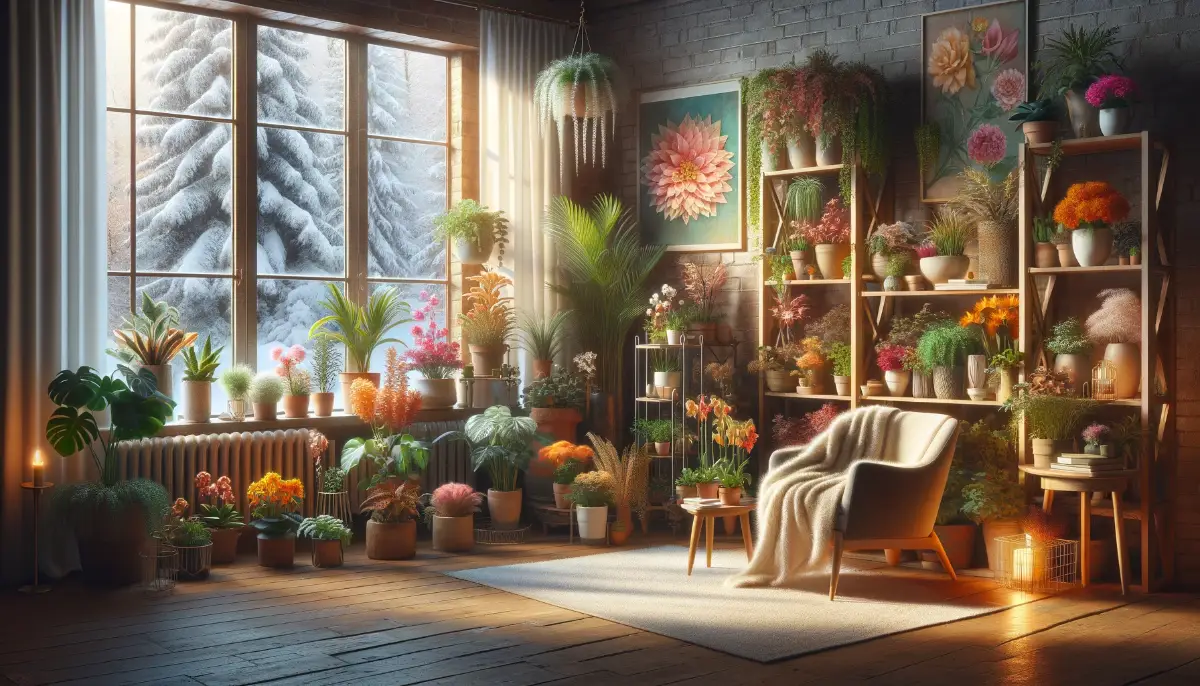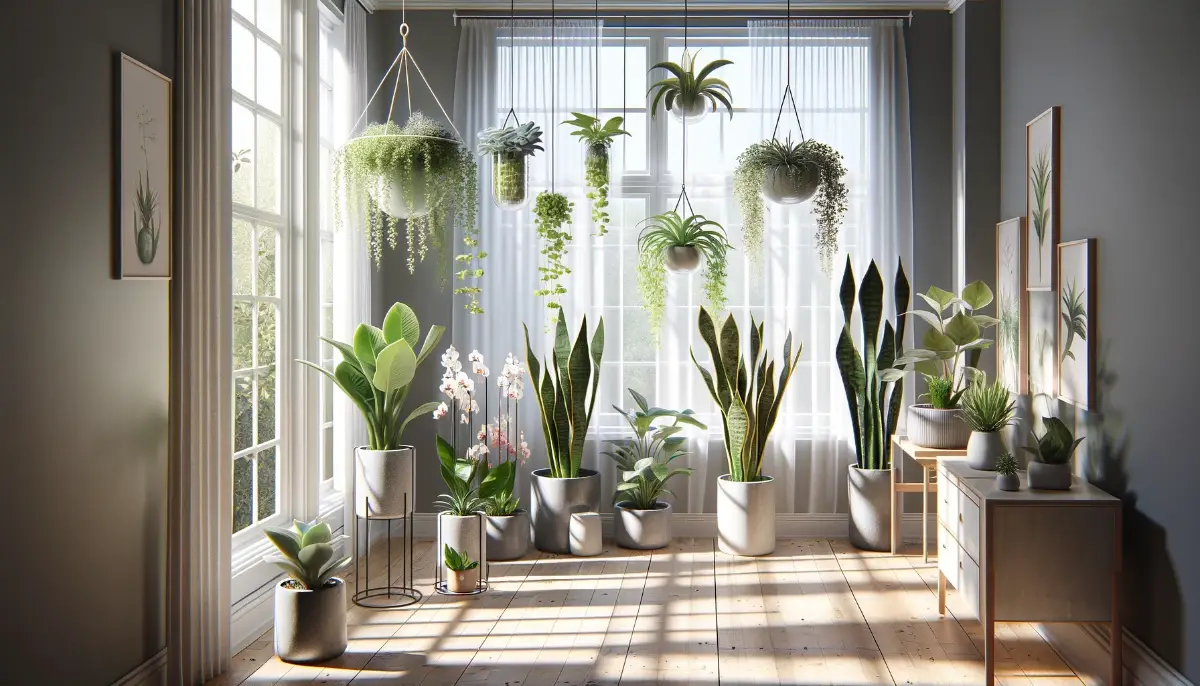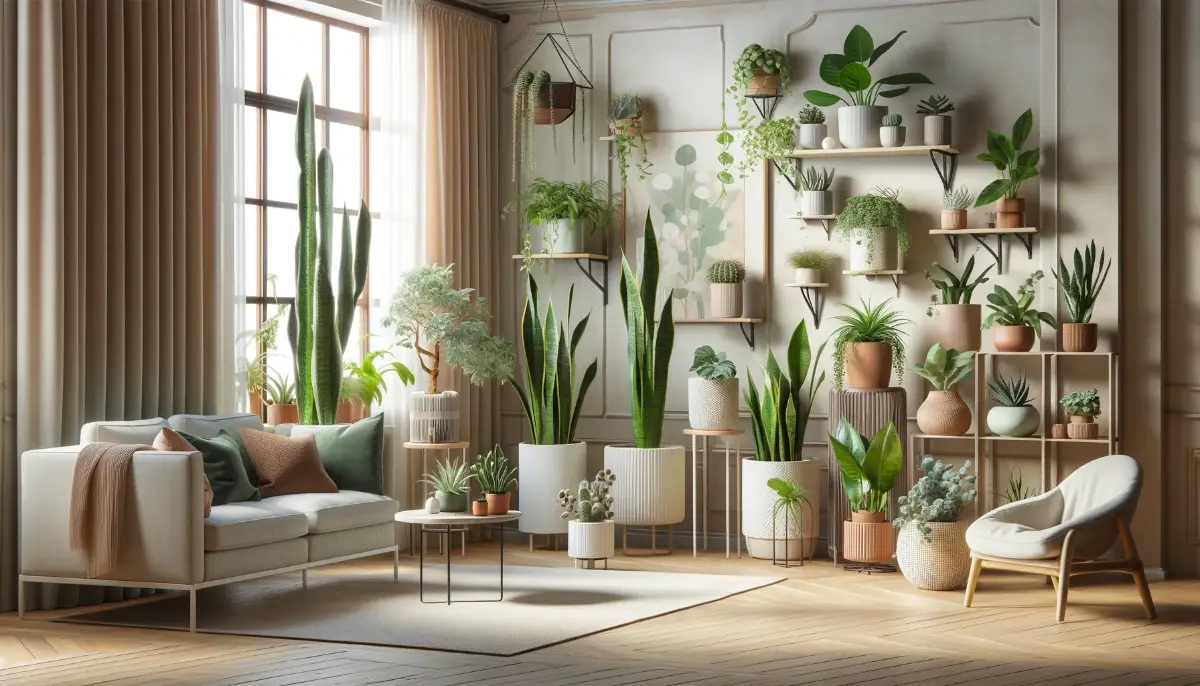Houseplants aren’t just for the spring and summer. The colder months can also be brightened by a selection of winter-blooming houseplants, bringing life and color into our homes when the outside world is often gray and dormant.
These vibrant blooms not only add aesthetic appeal to indoor spaces but also improve air quality and boost mood during the shorter days of winter. Among the array of houseplants that flourish in winter, some stand out for their beauty and ease of care, promising a touch of spring in the heart of winter.
- Winter-blooming houseplants can thrive indoors with the right light, water, and soil conditions.
- Flowering Maple, Kaffir Lily, and Jasmine are just a few plants that can bring color and fragrance to your winter home.
- Even in the coldest months, your home can be a lush, blooming oasis with the proper care and selection of plants.
Selecting the Perfect Winter-Blooming Houseplants
Flowering Maple (Abutilon spp.)
The Flowering Maple is an intriguing houseplant with its nonstop blooming habit. Its unique, lantern-shaped flowers and palmate, maple-like leaves create an appealing visual display. Some varieties come with variegated leaves, adding to the plant’s charm.
While it’s a robust bloomer, handling the plant might require gloves due to the irritation its leaves can cause. This plant’s continuous flowering ability makes it a stellar choice for adding winter color to your home.
Kaffir Lily (Clivia miniata)
The Kaffir Lily requires a period of chilling to initiate the bloom of its lily-like flowers. Ideal for indoor environments, it thrives in bright, indirect light, especially when placed near a north-facing window.
Despite its beautiful orange or yellow blooms, it’s important to note that the Kaffir Lily contains toxins that can be harmful if ingested in large quantities. Its low humidity requirement and striking blooms make it a winter favorite.
Jasmine (Jasminum)
Jasmine is typically known for its summer blooms, but it can also grace the winter months with its presence. To ensure its sweet fragrance and delicate flowers fill your home in winter, it requires a period of darkness in the fall.
Proper care after blooming helps manage its growth and prepares it for the next blooming cycle. Jasmine’s ability to adapt to indoor lighting conditions and its non-toxic nature make it a popular choice for winter blooming.
Begonia
Begonias are celebrated for their year-round flowering potential and colorful leaves. These plants thrive in bright, indirect light and can continue to bloom even in winter’s shorter days. Their ability to flower prolifically in shady conditions indoors makes them a versatile addition to any winter indoor garden.
Kalanchoe
As a succulent, the Kalanchoe is an exception to the typical indoor plant. It flourishes under bright, indirect light, showcasing clusters of small, bell-shaped flowers. This plant’s resilience and the vibrant colors of its blooms make it a cheerful presence during the winter months.
Amaryllis (Hippeastrum)
Amaryllis stands out with its bold, audacious blooms that can brighten any winter day. This plant is surprisingly easy to care for, requiring just a pot and some soil to get started. For those who might have forgotten to pot their Amaryllis bulbs during the holidays, worry not, as these plants can still provide spectacular blooms during winter.
With a preference for bright, indirect light and well-draining soil, Amaryllis is a low-maintenance plant that offers a long-lasting display of flowers.
Primrose (Primula)
Primroses inject vibrant colors into the winter home with their outrageously colorful flowers. They come in a wide variety of colors, including pink, lavender, yellow, red, and many more.
Primroses thrive under cool temperatures and bright, indirect light, making them perfect companions for the winter season. Their low rosettes of dark green leaves and sturdy stalks support clusters of eye-catching flowers, adding a splash of cheerfulness to any indoor garden.
Pink Jasmine
Pink Jasmine is another gem among winter-blooming houseplants, known for its sweet, intense perfume and dense clusters of flowers. It thrives in a cool environment with direct light, such as a south-facing window.
This plant is perfect for creating a spring-like atmosphere in your home during the colder months, with blooms set from December to March. Pink Jasmine’s ability to climb structures or dangle from hanging pots makes it a versatile addition to your indoor plant collection.
African Violet (Saintpaulia ionantha)
African Violets are remarkable for their ability to flower nearly year-round with proper care. They prefer bright light and warm conditions to encourage blooming.
With over 16,000 registered cultivars, there’s a vast array of options to choose from, including different flower shapes and colors, and even foliage types. African Violets are ideal for those looking for continuous blooms throughout the winter, providing a constant display of color and life in your indoor space.
The Beauty and Benefits of Blooming Houseplants
Winter-blooming houseplants offer a unique opportunity to infuse your home with color, fragrance, and life during the colder months. These plants not only brighten up indoor spaces with their vibrant blooms and lush foliage but also contribute to improving air quality and enhancing overall well-being.
The act of caring for plants can be a soothing and therapeutic activity, providing a sense of accomplishment and connection to nature as you watch them grow and flourish.
From the delicate and sweet-scented flowers of Jasmine and the vivid, cheerful blooms of Primroses to the stunning displays of Amaryllis and the year-round color of African Violets, each plant brings its own unique beauty and benefits. They serve as reminders of the resilience and beauty of nature, offering a splash of summer warmth during the winter season.
Moreover, winter-blooming houseplants are more than just decorative elements. They can become a hobby, a passion, or even a way to connect with others who share your interest in gardening. The variety available means there’s a plant out there for every level of gardening expertise, from the novice to the seasoned green thumb.
In conclusion, incorporating winter-blooming houseplants into your home decor not only enhances the aesthetic appeal of your living spaces but also provides psychological and physical benefits.
As we navigate the shorter days and colder nights of winter, these plants stand as a testament to the enduring beauty and diversity of the plant kingdom, bringing joy, color, and life into our homes when we need it most.
FAQs for Winter-Blooming Plants at Home
What are some popular winter-blooming houseplants?
Popular winter-blooming houseplants include Amaryllis, Jasmine, African Violet, and Kalanchoe. These plants offer vibrant colors and fragrances, bringing life to your indoor spaces during the colder months.
How often should I water my winter-blooming plants?
Watering frequency for winter-blooming plants varies, but a good rule of thumb is to water when the top inch of soil feels dry to the touch. Be cautious of overwatering, especially during winter, as plants typically require less water during the colder, less active growing season.
Do winter-blooming houseplants need special soil?
Yes, most winter-blooming houseplants thrive in well-draining soil. Specific mixtures might be recommended for different types, such as African Violets, which prefer a lighter, more porous mix to prevent root rot.
Can winter-blooming plants survive in low light?
While some winter-blooming plants like Pothos and Snake Plants can tolerate low light, most flowering plants require bright, indirect light to bloom. Research each plant’s specific light requirements for optimal growth.
How can I encourage my houseplant to bloom in winter?
To encourage blooming, provide adequate bright, indirect light, keep the plant in a cool room (if it prefers lower temperatures), ensure the plant is not over or under-watered, and consider using a fertilizer designed for blooming plants.
Are there any winter-blooming plants that are pet-safe?
Yes, many winter-blooming plants are safe for pets, including African Violets and Christmas Cactus. However, always check the specific plant species for toxicity before bringing it into a home with pets.
How do I deal with pest problems on my winter-blooming plants?
Keep an eye out for common pests like aphids and spider mites. Treat infestations early with insecticidal soap or neem oil, and isolate affected plants to prevent spreading.
What is the best temperature for winter-blooming houseplants?
The ideal temperature varies among species, but most winter-blooming plants prefer cooler temperatures at night to mimic their natural environment, which can encourage blooming.
Can I use artificial lights to support my winter-blooming plants?
Yes, artificial grow lights can supplement natural sunlight, especially in areas where winter days are short. Ensure the lights are the correct spectrum for plant growth and are placed at an appropriate distance from the plants.
What should I do if my winter-blooming plant stops flowering?
If your plant stops flowering, ensure it’s receiving enough light, the temperature is appropriate, and it’s not over or under-watered. Some plants may also require a resting period to bloom again, so researching your specific plant’s needs is crucial.









